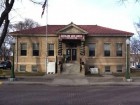Today I dropped into the Carnegie Art Center in Goodland, Kansas, a county seat on the state’s Western flank. Goodland has a population of 4,948 people and one of them is my father, so although I’ve never lived here myself, I’ve visited with some regularity.
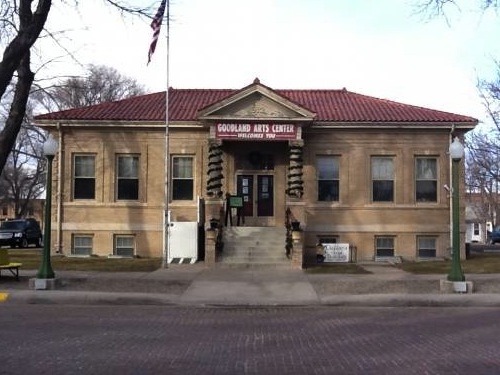
Carnegie Arts Center in Goodland, Kansas
The art center is in a landmark stone building put up in 1913 as the Carnegie Library; after the town built a bigger library, the art council took it over. In January, the calendar of exhibitions has a pause for rest and grant-writing. So the walls were still hung with a group show put together for the holidays, including Beyond the Universe, an abstract watercolor attributed to Elwyn Vatcher, gallery volunteer, and adorned with a big, red bow.
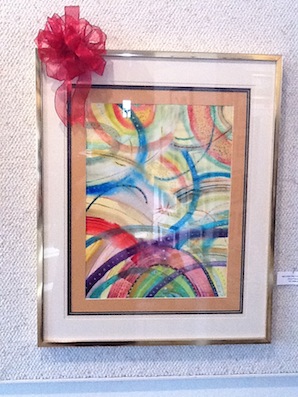
Elwyn Vatcher, <em>Beyond the Universe</em>, nd
That red bow was a complication, a signifier, a sign to me that I am, really, still in Kansas, although Vatcher’s painting speaks a modernist language that is now familiar almost everywhere. The ribbon is blatant, sweet, pushy (its red loops insist on echoing the red arcs in the painting); a little shocking to someone accustomed to more discreet displays. I don’t know what it meant to the gallery; to me it straddled the line between a red dot and a county fair prize with a dollop of “I’m a gift” thrown in. Back in California I might have taken it as a bit of ironic assemblage; but a few other pieces also sported bows so I’m pretty sure that whatever it meant, it was sincere.
And I’m inclined to appreciate that sincerity, having received some of my own art education at a similar community gallery in Wichita. As I look out towards the prairie from my hotel room, it seems right that this first Art & Shadows should come from Kansas, and from a small town. The questions I want to explore in this blog, questions about the art world and about what art is, how we know art when we see it, and what it means in our lives, are my questions in part because of where I grew up. I am passionately involved with contemporary art, but I’ve never gotten comfortable with the disconnect between art now and art here. For example, there’s a lot of talk about “community” in the works I encounter in my everyday life as an artist, writer, and teacher; but the thinking doesn’t always seem to encompass the kind of community consciousness shared by the rural people who live here. Sometimes the word seems to mean as many different things as that red bow.
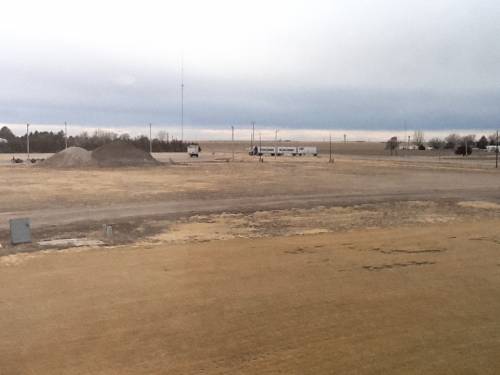
The view from my room at the Holiday Inn
Back in my hotel room, the view doesn’t deliver a lot of inspiration, so I go online and discover the work of Thai artist Arin Rungjang, through art historian Moira Roth’s highly-recommended blog Gleanings (part of the upcoming Biennale of Sydney). Roth links to video from Let’s Make Sense, a 2011 project in which Rungjang taught a group of Dutch people to cook Thai food. He talks about the dinner that resulted, at West, a gallery in Den Haag, as a spiritual experience, sharing food, talking about daily life and common experiences. In some ways it’s the kind of experience that probably happens in Goodland on most Sundays. But framed by a gallery it seems more significant somehow—perhaps not least in that the participants must have a degree of self-consciousness about what they are doing; it’s special, not “normal.”
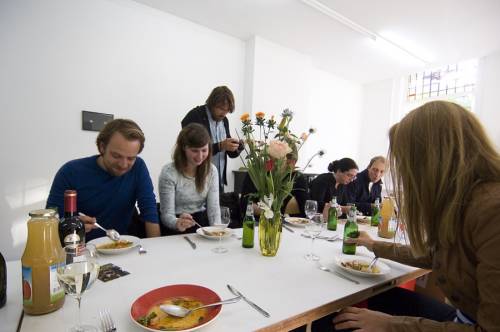
Rungjang's collaborators on <em>Let's Make Sense</em> included Kornkrit Jianpinidnan, Chitti Kasemkitvatana, Sivaroj Kongsakul, Shooshie Sulaiman, his mentor Rirkrit Tiravanija and the cooking "students" shown here. Photo courtesy West
“Making special” is what makes art Art and there are good biological reasons why that would be the case, according to evolutionary theorist Ellen Dissayanake (whose ideas we will discuss further in future posts.) Whatever “community” builds at the dinner will most likely be fragile and transient—it’s hard to imagine calling on someone you met once at a gallery to pick your kid up at school or bring you soup when you have the flu. But if working with Rungjang makes his audience think about community, noticing its presence in their life in a different way, then by Dissayanake’s lights the project would be a successful work of art.
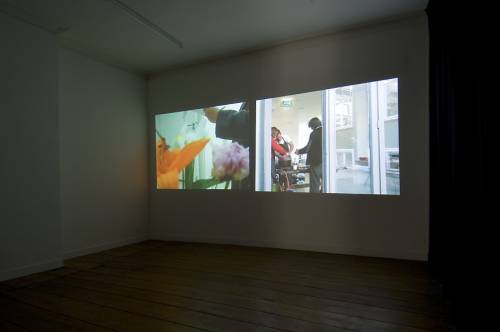
The final installation of <em>Let's Make Sense</em> in the West Gallery, video of the dinner. Photo courtesy West
But it could go further. The word “community” is often used in art discourse as if it referred to a positive good, something equivalent to health or happiness. But it simply means “a social group of any size,” and the formation of social groups is, by definition, an exclusionary as well as an inclusionary process. Some people are in and some people are out. Rungjang’s own family was scarred by an exclusionary manifestation of community: while in Germany as part of a ship’s crew, his father was beaten so badly by a group of Neo-Nazis, apparently just for being Asian, that he lost consciousness for two days. He died a year later, having never fully recovered his health. When Rungjang talks about his art, he attributes his motivation to this family tragedy, telling Roth that “it brought me to my interest in the ideologies of the world and the separations that they establish between people.”
Rungjang is to be lauded for tackling a big question—in his next project, a video for the Biennale of Sydney, he works with children who were orphaned by the malignant community feeling that erupted in the Rwandan Genocide. I am curious to see how his rhetoric about community develops through this work. In the meantime, next week Art & Shadows will pursue an investigation into social groups and the roots of art through the videos and installations of Rachel Mayeri, creator of Primate Cinema. And maybe, eventually, get back to the subject of “making special” and that big red bow.
Links:
